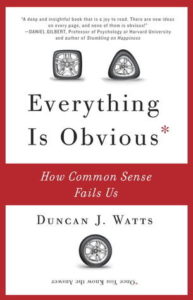Here’s the Gist:

- Duncan Watts is a sociologist and principal researcher at Microsoft Research. His latest book is Everything Is Obvious (Once You Know the Answer): How Common Sense Fails Us.
- Personal preference, though not entirely arbitrary, is likely constructed and justified on the fly.
- According to Watts, the problem with prediction is not that we’re good or bad at it, but rather we are bad at distinguishing predictions that we can make from those we can’t.
- Business should embrace “strategic uncertainty” and “measure-and-react strategies.”
Nir’s Note: This book review is by Sam McNerney. Sam writes about cognitive psychology, business, and philosophy.
At a special event in the Yerba Buena Center in San Francisco, the CEO of Apple Tim Cook riffed on Apple’s latest gadget, the Apple Watch. “It’s the most personal device we’ve ever created,” Cook said. “It’s not just with you; it’s on you. And since what you wear is an expression of who you are, we designed Apple Watch to appeal to a whole variety of people with different tastes and preferences.”
In just one sentence, Cook perfectly captured the genius of Apple, insisting that technology is not just about selling great products but merging them with lifestyle and identity. We no longer use electronics. They’ve become an expression of who we are.
The seductive appeal of Apple raises a fascinating question about how the human mind calculates preference. For most of the 20th century, social scientists believed that people possessed a set of fixed preferences. We may not have a detailed understanding of these preferences—we may not know why we like a certain wine or song or a burger joint—but we believe that there are things in the world that we prefer.
In the last few decades, psychologists have discovered that this view of human nature is at best limited. Research shows that the music playing in a liquor store influences our choice of wine, that the font and size in which something is written can make it more or less credible, and that we’re more likely to recycle hotel towels after reading that everyone else does. We report that we love Wes Anderson films, but when the weekend arrives, we opt for Michael Bay’s Transformers.
These studies are not making the rather innocuous observation that smart marketing matters, or that self-reports are unreliable. They reveal the more groundbreaking finding that the notion of “true” preference might be a myth. More likely, preferences, though not entirely arbitrary, are pieced together and justified on the fly.
Just So Stories
The idea that preference is constructed is one of the essential themes of Duncan Watts’ Everything is Obvious: Once You Know the Answer. Watts’ broader point is that common sense—a seemingly useful tool for understanding the world and oneself in it—is mostly an inexhaustible source of just-so stories designed to confirm purpose and instill agency where both may not exist. Common sense tells me that I’m a good person willing to donate my organs for the greater good. More likely, I’m an average guy who, like others, is highly susceptible to the default choice on the DMV form.
If our folk theories of individual behavior are systematically flawed, then our mental models of collective behavior are even worse. Trends, memes, cultural icons—everything from Shakespeare to Hush Puppies emerge from the collective behavior of human beings. We get together in groups to share information, spread rumors, meet new people, form new friendships, talk about what we like to eat, what we like to watch, and what we think is right or wrong.
According to Watts—a sociologist, physicist, and principal researcher at Microsoft—when we explain social phenomena, we tend to focus on the thoughts or intentions of the individual parts, or fictitious clusters like “the market” or “the economy.” Yet explanations that rely on a single cause to explain complex social phenomena typically gloss over the exceedingly intricate and chaotic nature of human interaction.
Foibles of Common Sense

“..the Mona Lisa is famous because it’s more like the Mona Lisa than anything else.” Image credit: Wikipedia Creative Commons
For instance, Watts wonders why Mona Lisa is the most famous painting in the world. Most people point to its unique inherent qualities—the gauzy finish or the subjects’ enigmatic smile. “But what we’re really saying,” Watts writes, “is that the Mona Lisa is famous because it’s more like the Mona Lisa than anything else.”
For many centuries, the Mona Lisa was an obscure masterpiece owned by notability. In 1911, a disgruntled Louvre employee named Vincenzo Peruggia stole the Mona Lisa and smuggled it to its “rightful” home in Italy. Italians treated Peruggia like a hero, the French threw him in jail, and Marcel Duchamp adorned a mustache and goatee on a reproduction in 1919. The succès de scandale hurled the Mona Lisa into the spotlight while that enigmatic smile went unchanged.
How we explain group behavior also reveals the limits of common sense explanation. Watts considers a famous survey, The American Soldier, conducted by the U.S. Military during World War II involving 600,000 servicemen. In the 1960s the brilliant sociologist Paul Lazarsfeld discussed one of the survey’s major findings: “Men from rural backgrounds were usually in better spirits during their Army life than soldiers from city backgrounds.” It makes sense. Soldiers from rural backgrounds were happier because they were better accustomed to dealing with harsh living standards. Effete city intellectuals, on the other hand, struggled to cope with the brutal psychological realities of war. It’s a fairly obvious finding… Right?

Image credit Wikipedia Creative Commons
Not exactly. Lazarsfeld revealed that this “finding” is the exact opposite of what the survey actually uncovered. Soldiers from the city, not rural areas, were happier during wartime. Of course, had Lazarsfeld told readers the correct answer first, they would have just as easily constructed a narrative about why it made sense—why, for example, city dwellers were used to crowded conditions, stricter social etiquette, and command and control style hierarchies. “If the correct answer and its exact opposite appear equally obvious, then, as Lazarsfeld puts it, ‘something is wrong with the entire argument of ‘obviousness.’”
Thinking More Clearly
In the final third of Everything is Obvious, Watts explores the foibles of prediction and strategic planning. We learn less from history than we think we do, he says, and this illusion further distorts our ability to forecast the future.
Watts prescribes a few heuristics to help us think more clearly about the future. The first is so simple that most people ignore it: distinguish domains in which we can confidently rely on data to make predictions from domains where randomness plays a big role or domains dominated by unexpected shocks. Predicting when Halley’s comet will next swing by Earth is easy because physical laws are stable—figure out the laws, figure out the path of the comet. Predicting who will win the next Super Bowl is harder because chance plays a significant role over the course of an NFL season, even though the rules of football and the dimensions of the field are fixed. Predicting the stock market is probably impossible, especially over the long term. Unlike physics and football, it is prone to unforeseeable shocks and sensitive to smart random variations.
Forecasting is such a difficult business not just because reliable data is hard to find but also because it’s hard to know what data matter. To paraphrase Watts, humans are generally good at perceiving which factors are relevant to a particular problem—a pitchers’ ERA is a better indicator of future performance than his relationship status—but they are generally bad at judging how important one factor is relative to another—is ERA more important than the Wins? What about more obscure baseball statistics like FIP and K/9 ratio?
And what’s worth predicting in the first place? “Making the right prediction is just as important as getting the prediction right,” Watts says.
One solution is to embrace “strategic uncertainty.” Watts details Michael Raynor’s book The Strategy Paradox, in which Raynor convincingly demonstrates that in many cases, the main cause of strategic failure, such as Sony’s MiniDisc, is not bad strategy but bad luck. The vision was clear, leadership strong, and execution flawless, but a black swan emerges—the Internet, Automobiles—and undermines everything. “Strategic uncertainty” assumes that even the best-laid plans are prone to unexpected changes and plans for a range of scenarios—even scenarios that seem unimaginable.

Image Credit Wikipedia Creative Commons
Watts also endorses the “measure-and-react strategy.” The Spanish clothing retailer Zara, for example, admits that it cannot anticipate what shoppers will buy next season. Instead, it pays agents to scour shopping malls to observe what consumers are already wearing. Then, a team creates a massive portfolio of the styles, fabrics, and colors that are trending and sends the portfolio to stores where everything is tested. Zara’s flexible and swift manufacturing and distribution makes it possible to design, produce, and ship new garments anywhere in the world in just over two weeks.
Of course, the logic behind “measure-and-react” has become widespread among Internet companies. Before Google or Huffington Post or Buzzfeed introduce a new feature, they test it, usually on a small portion of users. With feedback and observational metrics, it’s easier for these companies to know, compared to the opinion of one expert, what to keep and what to abandon.
“Whenever it comes to questions of business strategy or government policy, or even marketing campaigns and website design, we must rely less on our common sense and more on what we can measure,” Watts says.
When Steve Jobs famously remarked that people don’t know what they want until you show it to them, he probably wasn’t contemplating the details of the psychology of preference construction. And yet, he perfectly captured decades of research showing how common sense reasoning and everyday introspection can lead us astray. Apple geniusly merges technology with lifestyle not by tapping into the pre-existing identity of its customers but by creating one. Apple doesn’t sell products that we prefer; it creates the preference in the first place.
This distinction might sounds like a snobby cultural critique, a warning that Apple is shamelessly exploiting a vulnerable part of our minds. In reality, Apple is simply thinking clearly about how common sense actually works, insisting that what customers say they like is not a good indicator of what they’ll end up buying. This gap–the gap between what we say and what we do, what we think will happen and what actually happens–is a fascinating component of human psychology that Watts brilliantly weaves into Everything Is Obvious.
“The paradox of common sense,” he concludes, “is that even as it helps us makes sense of the world, it can actively undermine our ability to understand it.”
Related Articles
- Schedule Maker: a Google Sheet to Plan Your Week
- Habit Tracker in Google Sheets – Free Template
- A List of 20 Values [and Why People Can’t Agree On More]
- Timeboxing: Why It Works and How to Get Started in 2024
- An Illustrated Guide to the 4 Types of Liars
- Hyperbolic Discounting: Why You Make Terrible Life Choices
- Happiness Hack: This One Ritual Made Me Much Happier
